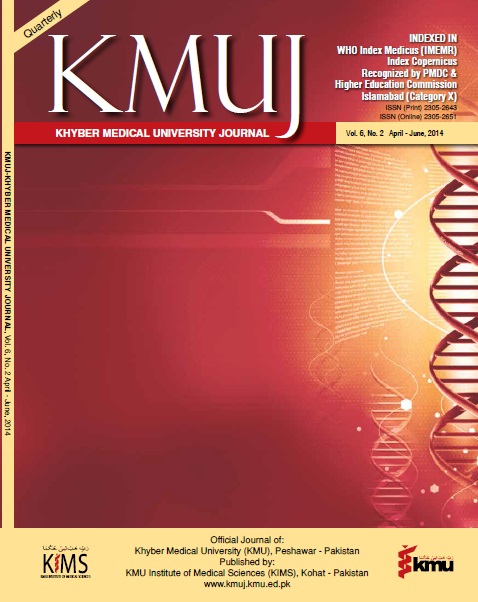ROLE OF PNEUMATIC LITHOTRIPSY IN PAEDIATRIC BLADDER STONES - “I WILL NOT CUT UPON STONE!”
Main Article Content
Abstract
Objective: To study the effectiveness and safety of pneumatic lithotripsy in paediatric bladder stone disease.
Methodology: This descriptive study was conducted at department of urology at institute of kidney diseases Hayatabad Peshawar from 01-01-2009 till 30-03-2013 on 120 children with bladder stones, selected by nonprobability convenient sampling technique. Stones in the bladder were fragmented by pneumatic lithotripsy using straight working channel paediatric cystoscope. All the pre-operative, per-operative and postoperative data was recorded on structured Proforma and was analyzed on SPSS version 17.
Results: The mean age of the patients was 6.2+2.03 years (range 3-12 years). The mean stone size was 14.1+3.30 mm. Forty-five (37.5%) patients presented with crying while micturation and pulling of the penis, 40 (33.3%) patients with recurrent febrile urinary tract infection and 35 (29.2%) patients with acute urinary retention. Stone was completely fragmented in 97.5% (n=117) cases. Mean operative time was 27.5+5.48 min (range 15-40 min) and the mean hospital stay was 1.23+0.65 days (Range 1-3 days). Bladders stone were successfully fragmented with pneumatic lithoclast in 97.5% (n=117) of cases. The patients with failed procedure (2.5%) were subjected to formal vesicolithotomy in same setting. All the patients were completely stone free by 3rd postoperative day. Early complications were recorded in 12.5% (n=15/120) cases including mild haematuria (5%), pain in urethra (4.2%), febrile UTI (2.5%) and unable to void (0.8%). There was no urethral stricture recorded during 18 months of follow up.
Conclusions: Pneumatic lithotripsy is minimally invasive, effective and safe modality in management of paediatric bladder stone.
Article Details
Work published in KMUJ is licensed under a
Creative Commons Attribution 4.0 License
Authors are permitted and encouraged to post their work online (e.g., in institutional repositories or on their website) prior to and during the submission process, as it can lead to productive exchanges, as well as earlier and greater citation of published work.
(e.g., in institutional repositories or on their website) prior to and during the submission process, as it can lead to productive exchanges, as well as earlier and greater citation of published work.
References
Ellis H. A history of bladder stone. J R Soc Med 197; 72(4): 248–51.
Thomalla JV. The myth of stone. Lithotomy history and the Hippocratic Oath. The myth of stone. Lithotomy history and the Hippocratic Oath. Indiana Med 1989;82(6):434-9.
Alaya A, Nouri A, F Najjar M. Epidemiological changes of paediatric urolithiasis in Tunisia. Tunis Med 2012;90(7):518-23.
Safaei Asl A, Maleknejad S. Pediatric urolithiasis: An experience of a single center. Iran J Kidney Dis 2011;5(5):309-13.
Sharma AP, Filler G. Epidemiology of pediatric urolithiasis. Indian J Urol 2010; 26(4):516-22.
Brisson P, Woll M, Parker D, Durbin R. Bladder stones in Afghan children. Mil Med 2012; 177(11):1403-5.
Rizvi SA, Naqvi SA, Hussain Z, Hashmi A, Hussain M, Zafar MN et al. Management of pediatric urolithiasis in Pakistan: experience with 1,440 children. J Urol 2003;69(2):634-7.
Ullah S, Chaudhary IA, Masood R. A comparison of open vesicolithotomy and cystolitholapaxy. Pak J Med Sci 2007;23(1): 47-50.
Lebowitz RL, Vargas B. Stones in the urinary bladder in children and young adults. Am J Roentgenol. 1987;148(3):491-5.
Salah MA, Holman E, Khan AM, Toth C. Percutaneous cystolithotomy for pediatric endemic bladder stone: experience with 155 cases from 2 developing countries. J Pediatr Surg 2005;40:1628-3.
Al-Marhoon MS. Comparison of endourological and open cystolithotomy in the management of bladder stones in children. J Urol 2009;181(6):2684-8.
Ali L, Orakzai N. Role of pneumatic lithotripsy by using ureterscope in paediatric bladder stones: “I will not cut upon stone”. European Urol supplements 2011; 10: 501–25.
Degnari RA, Jalbani MH, Abro MA. Trans-uretheral cystolithotripsy for bladder calculi in children. Medical Channel 2009;15(4):110-3.
Khosa AS, Hussain M, Hussain M. Safety and efficacy of transurethral pneumatic lithotripsy for bladder calculi in children. J Pak Med Assoc 2012;62(12):1297-1300.
Herr HW. 'Cutting for the stone': the ancient art of lithotomy. BJU Int. 2008;101(10):1214-6.
Papatsoris AG, Varkarakis I, Dellis A, Deliveliotis C. Bladder lithiasis: from open surgery to lithotripsy. Urol Res. 2006;34(3):163-7
Isen K, Em S, Kilic V, Utku V, Bogatekin S, Ergin H. Management of bladder stones with pneumatic lithotripsy using a ureteroscope in children. J Endourol. 2008;22(5):1037-40
Uygun I, Okur MH, Aydogdu B, Arayici Y, Isler B, Otcu S. Efficacy and safety of endoscopic laser lithotripsy for urinary stone treatment in children. Urol Res 2012;40(6):751-5.
